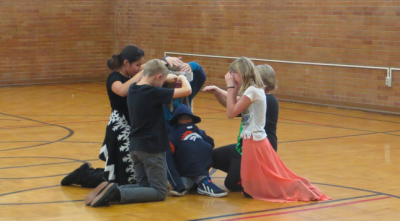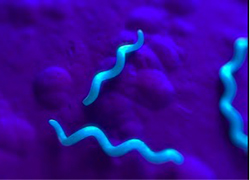SUBJECTS
GRADE
Show Results
Bacteria and Fungi

Lesson Summary
- Explore dance movements that mimic the shapes of bacteria and fungi.
- Recognize bacteria and fungi by their appearances and other characteristics.
Lesson Plan and Procedure
Lesson Key Facts
- Grade(s): 6
- Subject(s): Dance, Science
- Duration of lesson: 40 minutes
- Author(s): Jana Shumway
Before class, make a mess in the gym/room by randomly placing ribbons, exercise balls, and swimming noodles all over the floor.
Experience/Identify
Start off by dancing the following movements with no explanation. (Do not say the key words—just dance and have the students follow you.)
Note: In between shapes, have students hold their shape and freeze.
Play "Fireflies" by DJ ReDo.
| Bacteria | Movement |
|---|---|
| Small | Start in a small shape, then move in small ways: small shoulder movements, small arm movements, small hand movement, and so on. |
| Alive | Staying in one spot, do big axial movements: big arms, circling torso, turns, deep knee bends, twisting, stretching, and such. |
| Everywhere | Run anywhere for counts one, two, three, four; freeze for counts five, six, seven, eight. Repeat three times. (During the freezes, create shapes that are stuck to the walls, on the floors, facing upward, on a variety of levels, connected to other people, and so on.) |
| Simple | Move only the head very slowly from one direction to another. |
| Replicate | Call out one student’s name. Have that student run to the center of the room and create a shape, then cue another student to run into the center and connect to the other student already there. Continue in a variety of shapes on different levels. |
| Copy | Have the students grab a partner’s hand and pull him or her out of the previous group of students. Together, have them create a huddle, then break apart and create individual shapes. Repeat: huddle, then break apart. |
| Spherical | Create circles of all kinds: circle shapes, circling arms, circling heads, circling floor patterns, circling air patterns, and so on. |
| Rod | Create several long straight shapes: on the ground, with just arms, with the whole body, with just legs, or other possible ways. |
| Spiral | Do spiraling and twisting movements for counts one, two, three, four, and hold a spiraled shape for counts five, six, seven, eight. Repeat three times. |
| Help | Have the students take a partner’s hand and “help” him or her travel around the negative space of the ribbons, over the exercise balls, and over and around the noodles. |
| Hinder | Stop suddenly and do staccato movement with arms, legs, torso, behind yourself, and so on. |
| Break Down | Do lots of little collapses until you reach the floor. Start high, collapsing your head, then shoulder, torso, hips, and knees and end on the ground. Repeat the movement sequences above again, this time saying the key words as you dance each. Continue to guide the students through the same dance, but emphasize the key words. At the end, ask the students if they can guess what they are dancing about. |
Explore/Investigate
After they’ve guessed what they are dancing about (or after you have told them), repeat the dance a third time and explain the key words as they dance each section.
At this point, students will know the movements, so you will not need to explain the dance. Just teach them all about bacteria.
| Bacteria | Movement |
|---|---|
| Small | Bacteria are so small, you can only see them through a microscope. |
| Alive | Bacteria are alive. Yes, all bacteria are living! |
| Everywhere | Bacteria are found everywhere: in soil, in the bread we eat, in humans, in snow, on rocks. Everywhere. There are approximately 10 times as many bacterial cells as there are human cells in the body. |
| Simple | Bacteria are made up of simple cells that fall under the heading prokaryotic; therefore, they do not have an organized nucleus—or the brain of a cell. |
| Replicate | Bacteria love to replicate, which is their whole purpose in life. |
| Copy | One bacterium cell can divide and create two cells. |
| Spherical | Bacteria come in three different types of shapes. One shape is spherical, like a ball. |
| Rod | Another bacteria shape is a rod shape, or bacilli. It looks like a gummy worm. |
| Spiral | Bacteria are found in spiral shapes like spiral noodles. |
| Help | Bacteria can be very helpful. they help plants absorb nitrogen and help humans use the nutrients in food. Scientists use good bacteria to produce medicines and vaccines. |
| Hinder | However, some bacteria can be very harmful, causing sore throats, ear infections, cavities, and even pneumonia. |
| Break Down | Bacteria help to break down the food you eat. |
Repeat the dance again. (They learn so much from repetition.) This time, have the students tell you all they know about bacteria as they dance the dance. You’ll be surprised at how much information they’ll be able to repeat back to you!
Connect/Analyze
Note: The next section is not as movement based, but rather focuses on creating a visual of what bacteria look like in a microscope.
Use the drum as accompaniment.
Explain that when looking though a microscope, bacteria can be found in the following shapes:
- Cocci (sphere): pairs, singles, chains, and clusters
- Bacilli (rod): pairs, singles, chains, and flagellated bacilli
- Spirochete (spiral): Borrelia, Treponema, and Spirilla



Call out the names of the above shapes and have them respond using the props laid out in the room (exercise balls, ribbons, and swimming noodles).
| Bacteria | Movement |
|---|---|
| Spherical Pairs | Put two exercise balls together, sit, and bounce on them. (If using smaller balls, just create shapes while holding the balls together as partners.) |
| Spherical Singles | Separate from the partnership, then sit and bounce on the balls. (Again, with small balls, just make a shape holding the ball.) |
| Spherical Clusters | Put the balls together in one to three large clusters and sit and bounce on them, or create a shape with them. |
| Bacillus Pairs | Put two swimming noodles together at the ends, forming a line. |
| Bacillus Singles | Hold up each swimming noodle without touching another swimming noodle. |
| Bacillus Chains | Create long chains by connecting several (or possibly all) of the noodles. |
| Flagellated Bacilli | Put the end of the ribbon in the noodle and sway the ribbon while dancing and holding the noodle. |
| Spiral Borrelia | Dance with the ribbon and have the ribbon create random S types of swirls. |
| Spiral Treponema | Move the ribbon up and down in a curved zigzag fashion. |
| Spiral Spirilla | Whip the ribbon high, then create an S curve and whip it low. |

Create/Perform
Take the previous idea of using key words to create small group dances about fungi.
You can inspire the dances with images of fungi (mushrooms, slime molds, birds’ nests, puffballs, truffles, brackets, cups, corals, earthstars, and so on). You can also inspire the dances with diseases such as athlete’s foot, tinea, and ringworm. Or you can inspire the dances with where fungi live: in soil, lakes, rivers, seas, air, or in and on plants and animals.
Have the students perform their dances for one another and explain the key facts they put into their dances and how they performed them through dance.
Learning Objectives
- Understand the simplicity and complexity of microorganisms.
- Understand that microorganisms are found almost everywhere and range from helpful to harmful.
- Examine the structures and shapes of microorganisms.
- Use a variety of movement possibilities, patterns, and structures.
- Demonstrate spatial relationships.
- Incorporate technical skills in dance sequence.
Utah State Board of Education Standards
This lesson can be used to meet standards in many grades and subject areas. We will highlight one grade’s standards to give an example of application.
Grade 6 Dance
- Standard 6.D.CR.4: Manipulate and expand movement possibilities to create a variety of patterns and structures and explain the reasons for and effectiveness of movement choices.
- Standard 6.D.P.1: Build partner and ensemble skills by demonstrating effective spatial relationships with diverse pathways, levels, and patterns in space.
- Standard 6.D.P.4: Embody technical skills to accurately execute locomotor and non-locomotor changes of direction, levels, facings, pathways, elevations and landings, extensions of limbs, and movement transitions.
Equipment and Materials Needed
- Ribbons
- Exercise balls (or small PE balls)
- Swimming noodles (preferably cut in half)
- Music track: “Fireflies” (instrumental version) by DJ ReDo
- Drum
Additional Resources
ignore
Image References
Image 1: BYU Arts Bridge Student Blogs: 2016, Tessa Homer (http://education.byu.edu/arts/bridge/2016).
Image 2: Pixabay (https://pixabay.com/en/bacteria-pathogen-infection-germs-1744856/).
Image 3: Wikipedia (https://en.wikipedia.org/wiki/Escherichia_coli#/media/File:EscherichiaColi_NIAID.jpg).
Image 4: ThoughtCo. (https://www.thoughtco.com/bacteria-shapes-373278).
Image 5: BYU Arts Bridge Student Blogs: 2016, Tessa Homer (http://education.byu.edu/arts/bridge/2016).

www.education.byu.edu/arts/lessons
 Download
Download